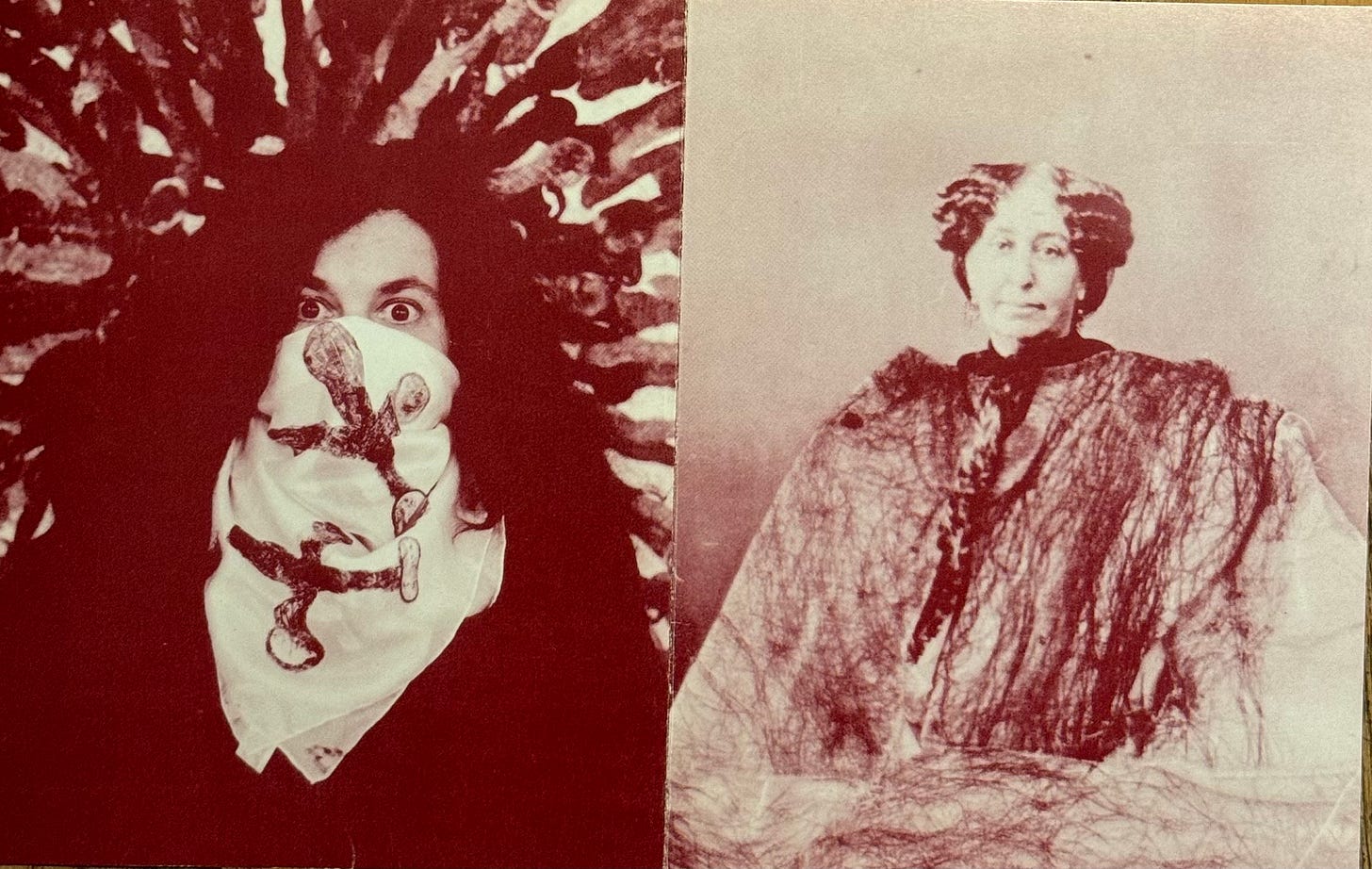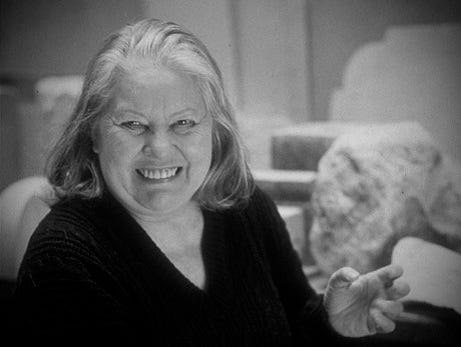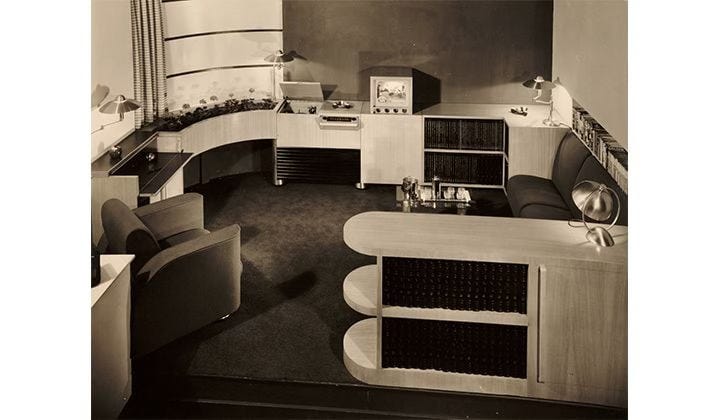Marginally Known: 9 Overlooked Artists of the Greek Diaspora
With illustrious international careers
Weirdly, I started Greek Visions - a concept devoted to the exploration of contemporary Greek culture - in London after having lived there for almost 4-5 years. That distance was probably one of the reasons why I decided to look back and go deep.
Similarly, many Greek artists throughout the years have travelled or moved to some of the world’s biggest cities to advance their studies and network, present their work to global audiences or just look for a better chance at pursuing art.
In this newsletter, we aim to highlight some artists from the Greek diaspora, who have had great careers, but remain relatively unknown in Greece.
Chrysanne Stathacos
Feminism, Greek mythology, eastern spirituality and Tibetan Buddhism inform Stathacos’ artistic practice, and that’s certainly quite an interesting mix.
Born in 1951, Chrysanne Stathacos is a Canadian American multidisciplinary artist, whose work encompasses print, textile, performance and conceptual art.
Amidst the AIDS crisis of the 1990s, Stathacos’ work became deeply engaged with body politics, and her commentary on issues of sexuality and gender became more pronounced. Some of her projects, such as ‘The Abortion Project’, remain relevant to this day.
We found out about Chrysanne Stathacos through an exhibition curated by Georgia Liapi in Canada and have been amazed by the breadth of her work ever since.
NONDA (Epaminondas Papadopoulos)
We were introduced to Nonda’s work very recently, after his son kindly messaged us on Instagram. The first image we saw was the above picture of him working on a huge trojan horse and we were instantly intrigued.
A Greek-French artist who lived most of his life in Paris, Nonda went through different phases, from figurative painting to sculpture and abstraction.
His Point Neuf exhibitions, involving a 24-hour, one-man show that took place by the river Seine in 1960, remain extremely interesting as they broke the confines of gallery spaces, with the blessing of France’s minister of culture André Malraux.
Theodoros Stamos
Stamos is probably the least overlooked, but most controversial artist in this list.
Born in New York City in 1922, Stamos studied painting and was part of the early generation of American abstract expressionists, otherwise known as the ‘Irascibles’. Being part of the group, he was included in the legendary LIFE Magazine group shot of them that is considered to have popularised the term ‘Abstract Expressionism’ (bottom left next to Rothko).
His career was tarnished by his involvement in the Rothko scandal.
He remains a favourite amongst Greek Prime ministers as his work has decorated the office of two former PMs, Giorgos Papandreou and Alexis Tsipras.
Stefanos Lazaridis
We’re briefly pivoting from fine art to stage design to highlight the incredible work of stage designer Stefanos Lazaridis.
Best known for his work in British opera, Lazaridis had an illustrious career at the English National Opera (ENO) and then went on to work on many amazing productions.
Originally his style was lavish and naturalistic, but he changed to a less traditional style while working with David Pountney and other more avant-garde directors at the English National Opera and elsewhere.
Between 2006 and 2007, Lazaridis was the artistic director and general manager of the Greek National Opera; during that time he found himself frustrated as he attempted to revitalise and redesign the company. As Pountney observed, "the Greeks have themselves to blame that they squandered such an astounding talent."
In his obituary, The Guardian called him ‘one of the most striking, and possibly most influential, opera designers in Britain during the last 30 years.’
Aglae Liberaki
Born in Athens, Greek sculptor Aglae Liberaki lived most of her life between Hydra and France. She studied sculpture under avant-garde sculptor Michael Tombros at the Athens School of Fine Arts.
In 1947 she married painter Yannis Moralis and in 1949 they both joined a newly founded group of artists called ‘Armos’, which featured numerous artists including Nikos Chatzikiriakos-Gkikas, Yannis Tsarouchis, Nelly Andrikopoulou and Margarita Liberaki (her writer and dramatist sister).
In 1950 Liberaki visited sculptor Henry Moore at his studio and he encouraged her sculptural activity. Having worked with brass for a number of years, she later concentrated on cutting stone and marble with traditional tools, and then added elements of cracks and knots.
Her work has been exhibited internationally and she has taken part in numerous competitions over the years. In 1976, Liberaki was named Knight of the Order of Arts and Letters of France.
Peter Voulkos
A legendary ceramicist and artist, Greek-American Peter Voulkos was known for bringing together ceramics and abstract expressionism techniques, crossing the traditional divide between ceramic crafts and fine art.
He went on to establish the Ceramics department at the Los Angeles County Art Institute and at UC Berkeley.
Voulkos' sculptures are known for their visual weight, their freely-formed construction, and their aggressive and energetic decoration.
He was also among those who raised ceramics to the non-utilitarian, aesthetic sphere, authorising his students to make a teapot, "only if it didn't work/wasn’t functional".
John Vassos
If Peter Voulkos was notorious for his non-utilitarian approach, John Vassos was the exact opposite.
Vassos’ design philosophy was to make products that were functional for the user and that’s what he did for almost four decades working as an industrial designer, illustrator and artist, who helped define the shape of radio, television and broadcasting equipment.
In 1939 he designed the first consumer television sets for RCA that were introduced at the New York World's Fair, and during World War II he developed camouflage techniques, sleek furniture and devices that made it to almost every home in America in the middle of the 20th century.
Agnese Udinotti
Despite her Italian name, Agnese Udinotti, was born in Athens in 1940, before moving to the USA as a teenager, scarred by the tragic execution of her father after World War II, during the Dekemvriana events, when Udinotti was only four years old.
Her work spans different mediums such as poetry, painting and sculpture. She has exhibited internationally, and has received numerous honours and awards for her work.
Udinotti also served as the poetry editor of the magazine Chimera.
In 2007, she founded the Udinotti Museum of Figurative Art in Arizona, exploring the symbolic use of the human form in art as a powerful communication tool.
Christopher Makos
Christopher Makos is an American photographer and visual artist. He began his career while being an apprentice for Man Ray and later as a photo assistant for Andy Warhol. He was a part of and captured the emergence of the contemporary art scene of New York.
Makos is known for his photographs of queer icons, pop stars and the male body. He has published a number of photo books and his work has been featured in publications such as the New York Magazine, Rolling Stone, Interview, and Esquire.
Makos is considered to have introduced Andy Warhol to the work of Jean-Michel Basquiat and Keith Haring and has photographed several moments of their legendary convergence like the below.
Honorable mentions
This list is by no means comprehensive. There are many Greek artists who have had significant international careers (some more and some less well-known in Greece), such as Lucas Samaras, Iannis Xenakis, Takis, Chryssa, Jannis Kounelis and Arianna Papademetropoulos to name a few.
If you liked this series and want to see more like it, let us know in the comments below or DM us!
That’s all for now, see you at the next one! In the meantime, you can follow us on Instagram or buy our merch.
















So inspiring - love the Trojan Horse!!
https://www.taki183.net/ Taki is recognized and credited often in the graffiti and street art world for the art of being recognized in NYC via tagging. This spawned a global cultural movement that still exists today.